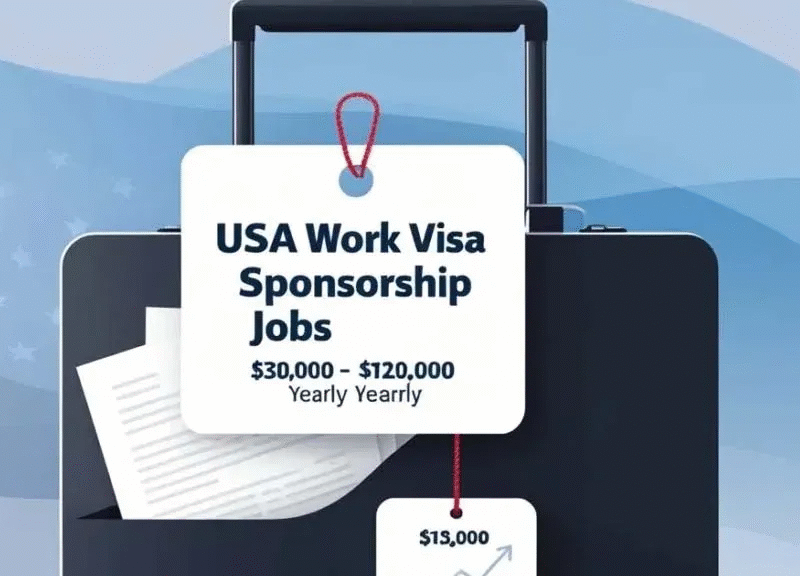For many, the American dream represents a life of opportunity, prosperity, and a fresh start. And now, whispers are circulating about a potential pathway that could make this dream a reality, and even put a hefty sum of cash in your pocket: to get paid $45,000 to relocate to the USA via the Construction Visa Program.
Yes, you read that right. A potential $45,000 incentive to embark on a new chapter in the USA, all while contributing your skills to the booming construction industry. In today’s global economy, skilled labor is in high demand, and the American construction industry is no exception. Facing a significant shortage of qualified professionals, companies in USA are actively seeking experienced workers from around the world.
This is where the Construction Visa Program shines, providing a legal and lucrative avenue for international talent to contribute to the nation’s infrastructure while building their own American dream. But is it too good to be true? Let’s delve into the details, separate fact from fiction, and explore whether this is a genuine opportunity for you.
The Demand: Fueling the Construction Visa Program – Understanding the US Labor Shortage
The United States, a nation built on infrastructure and continuous development, is currently grappling with a significant and escalating shortage of skilled construction workers. This isn’t a fleeting issue; it’s a systemic challenge rooted in several interconnected factors, creating a vacuum that the Construction Visa Program (primarily utilizing the H-2B visa) is designed to address.
To truly understand the potential of this program, we must dissect the intricate web of reasons behind this critical labor deficit.
- The Aging Workforce and the Skills Gap:
One of the most prominent contributors to the construction labor shortage is the aging demographic of the existing workforce. For decades, the construction industry has relied on a generation of skilled tradespeople who are now approaching or entering retirement. This exodus of experienced workers leaves a significant skills gap, as younger generations haven’t filled the void at the same rate.
- Decline in Vocational Training: A shift in societal emphasis towards four-year college degrees has led to a decline in vocational training and apprenticeship programs. This has resulted in fewer young people entering the skilled trades, exacerbating the labor shortage.
- Lack of Interest: Perceptions of construction work as physically demanding and less prestigious than other professions have also contributed to a lack of interest among younger individuals.
- Knowledge Transfer Deficit: The retiring generation carries with them decades of invaluable experience and specialized knowledge. The lack of effective knowledge transfer mechanisms has made it difficult to pass these skills on to younger workers.
- The Post-Recession Boom and Infrastructure Projects:
The economic recovery following the 2008 recession, coupled with government-funded infrastructure projects, has fueled a surge in construction activity. This increased demand for construction services has placed immense pressure on the already strained labor market.
- Infrastructure Investment: The passage of significant infrastructure bills has led to a wave of new projects, including road and bridge construction, public transportation upgrades, and renewable energy installations. These projects require a large and skilled workforce, further intensifying the labor shortage.
- Residential and Commercial Growth: A booming housing market and increased commercial development have also contributed to the demand for construction workers.
- Natural Disasters: The increasing frequency and severity of natural disasters have created a need for reconstruction and rebuilding efforts, adding to the already high demand for construction labor.
- Geographic Imbalances and Regional Shortages:
The construction labor shortage isn’t evenly distributed across the United States. Certain regions, particularly those experiencing rapid growth or facing significant infrastructure needs, are facing more acute shortages than others.
- Growth Hotspots: States and cities experiencing rapid population growth and economic development, such as Texas, Florida, and California, are facing particularly severe labor shortages.
- Rural Areas: Rural areas often struggle to attract and retain skilled construction workers, leading to delays and increased costs for infrastructure projects.
- Specialized Skills: Shortages are particularly pronounced in specialized trades, such as electricians, plumbers, and HVAC technicians.
- The Impact of Immigration Policies:
Changes in immigration policies and enforcement have also contributed to the construction labor shortage. Historically, the construction industry has relied on immigrant workers to fill labor gaps. However, stricter immigration regulations and enforcement have made it more difficult for foreign workers to enter the United States, further exacerbating the shortage.
- Reduced Availability of Labor: Stricter immigration policies have reduced the pool of available workers, particularly in entry-level positions.
- Increased Costs: The difficulty in finding qualified workers has led to increased labor costs for construction companies.
- Project Delays: Labor shortages have resulted in project delays and increased construction timelines.
The Role of the Construction Visa Program (H-2B)
In response to these challenges, the Construction Visa Program, primarily utilizing the H-2B visa, provides a legal pathway for U.S. employers to hire foreign workers on a temporary basis. This program is designed to supplement the domestic workforce and address critical labor shortages in the construction industry.
- Filling Critical Gaps: The H-2B visa allows employers to fill critical labor gaps in specialized trades and geographic areas facing acute shortages.
- Meeting Seasonal Demands: The program is particularly useful for meeting seasonal demands in the construction industry, such as during peak building seasons.
- Supporting Economic Growth: By addressing labor shortages, the H-2B visa program helps to support economic growth and infrastructure development in the United States.
However, the H-2B program is subject to annual caps and strict regulations, which can limit its effectiveness in addressing the overall labor shortage. The program is also subject to political debates and potential changes in immigration policy.
The demand for skilled construction workers in the United States is driven by a complex interplay of demographic trends, economic factors, and policy decisions. The Construction Visa Program represents one potential solution to this challenge, but it is not a panacea.
Addressing the labor shortage will require a multifaceted approach, including increased investment in vocational training, improved recruitment and retention strategies, and thoughtful immigration policies. Understanding the depth of this demand is the first step in understanding the opportunity that the construction visa program creates.
Essential Eligibility Requirements for Securing the Opportunity with the Construction Visa Program
The promise of a $45,000 relocation incentive and a fulfilling career in the U.S. construction industry is undeniably attractive. However, securing this opportunity is contingent upon meeting stringent eligibility requirements, primarily tied to the H-2B visa program. Understanding these requirements is crucial for anyone considering this pathway.
- Demonstrable Skills and Experience:
At the heart of the H-2B visa program lies the need for skilled workers. Employers are seeking individuals with proven expertise in specific construction trades.
- Specific Trade Skills: You must possess verifiable skills in a trade that is in high demand in the U.S., such as carpentry, electrical work, plumbing, masonry, welding, or heavy equipment operation.
- Documentation of Experience: Employers will require documentation of your work experience, including employment records, certifications, and training certificates.
- Practical Demonstrations: In some cases, employers may require practical demonstrations of your skills through interviews, tests, or on-site assessments.
- Licensing and Certifications: Certain trades may require specific licenses or certifications, either from your home country or from relevant U.S. authorities. Research which certifications are applicable to your trade.
- Job Offer from a U.S. Employer:
The H-2B visa is employer-sponsored, meaning you must have a valid job offer from a U.S. employer who is willing to petition for your visa.
- Employer Petition: The employer must file a Form I-129, Petition for a Non-immigrant Worker, with U.S. Citizenship and Immigration Services (USCIS).
- Labor Certification: The employer must obtain a temporary labor certification from the U.S. Department of Labor (DOL), demonstrating that there are no qualified U.S. workers available to fill the position.
- Bona Fide Job Offer: The job offer must be genuine and clearly outline the terms of employment, including wages, working conditions, and duration of employment.
- Employer’s Financial Stability: USCIS will assess the employer’s financial stability to ensure they can meet their obligations to the worker.
- Meeting the H-2B Visa Requirements:
The H-2B visa program has specific eligibility requirements that you must meet.
- Temporary or Seasonal Work: The job must be temporary or seasonal in nature. The H-2B visa is not intended for permanent employment.
- Non-Agricultural Work: The H-2B visa is for non-agricultural work. Agricultural work uses the H-2A visa.
- Country of Nationality: You must be a national of a country eligible to participate in the H-2B program. Check the USCIS website for the current list of eligible countries.
- No Criminal Record: You must have a clean criminal record. A criminal record may disqualify you from obtaining a visa.
- Medical Examination: You may be required to undergo a medical examination to ensure that you are in good health.
- Intent to Return: You must demonstrate that you intend to return to your home country after your authorized period of employment in the U.S.
- Language Proficiency:
While not always a strict requirement, English language proficiency can significantly enhance your chances of securing a job offer and successfully navigating the U.S. work environment.
- Communication Skills: Employers prefer candidates who can communicate effectively with supervisors, colleagues, and clients.
- Safety Instructions: Understanding safety instructions and regulations is crucial in the construction industry.
- Daily Interactions: Basic English language skills are essential for daily interactions and navigating life in the U.S.
- Financial Stability (for the initial period):
Even with potential relocation assistance, it’s advisable to have some financial resources to cover initial expenses.
- Initial Living Expenses: You may need to cover initial living expenses, such as housing, food, and transportation, until you receive your first paycheck.
- Emergency Fund: Having an emergency fund can provide a safety net in case of unexpected expenses.
- Adherence to Legal Processes:
Following the correct legal processes is paramount for a successful visa application.
- Accurate Documentation: Ensure that all your documents are accurate and complete.
- Timely Applications: Submit your applications and required documents within the specified deadlines.
- Avoid Fraudulent Activities: Do not engage in any fraudulent activities or provide false information. This can lead to visa denial and legal consequences.
Key Takeaways:
- The H-2B visa program is highly regulated, and meeting the eligibility requirements is crucial.
- Employers are seeking skilled workers with verifiable experience and a strong work ethic.
- Thorough preparation and attention to detail are essential for a successful visa application.
- It is always a good idea to consult with an immigration lawyer.
By understanding and meeting these essential eligibility requirements, you can significantly increase your chances of securing a rewarding career in the U.S. construction industry through the Construction Visa Program.
The $45,000 Incentive: Unpacking the Details and Understanding the True Financial Scope of the Construction Visa Program
The headline-grabbing figure of “$45,000 to relocate to the USA” through the Construction Visa Program is undeniably alluring, but it’s crucial to dissect this number and understand its composition. It’s not a simple, upfront payment, but rather a potential cumulative financial benefit accrued over a period of time. Let’s break down the intricate financial landscape and explore the various factors that contribute to this potential earning capacity.
- Relocation Assistance:
Moving to a new country involves substantial upfront costs, including travel, housing deposits, and initial living expenses. Recognizing this, some employers offer relocation assistance to ease the financial burden on incoming workers.
- Travel Expenses: This may include covering the cost of airfare, transportation to the worksite, and baggage allowances.
- Housing Assistance: Employers might provide temporary housing or assistance with finding affordable accommodation. This could involve covering the cost of a security deposit or providing a temporary housing stipend.
- Initial Living Expenses: Some employers may offer a stipend to cover initial living expenses, such as groceries, transportation, and utilities.
- Logistical Support: Assistance with obtaining necessary documents, such as social security numbers and driver’s licenses, can also be provided, which saves time and money.
- Building a Foundation for Financial Growth:
The U.S. construction industry generally offers competitive wages, particularly for skilled tradespeople. The potential to earn a higher income than in your home country is a significant financial incentive.
- Prevailing Wage Rates: The U.S. Department of Labor (DOL) sets prevailing wage rates for various occupations in different geographic areas. Employers are required to pay at least the prevailing wage to H-2B workers. This ensures that foreign workers are not underpaid and that U.S. workers are not displaced.
- Skill-Based Compensation: Wages are often determined by skill level, experience, and certifications. Highly skilled workers in specialized trades can command higher salaries.
- Regional Variations: Wages can vary significantly depending on the location. Areas with high demand and a shortage of skilled workers tend to offer higher wages.
- Overtime Opportunities:
Many construction jobs offer overtime pay, providing workers with the opportunity to significantly increase their earnings.
- Overtime Pay Rates: Federal law requires employers to pay overtime at a rate of 1.5 times the regular hourly wage for hours worked beyond 40 in a workweek.
- Project Demands: Construction projects often have tight deadlines and fluctuating workloads, leading to overtime opportunities.
- Availability and Willingness: Workers who are available and willing to work overtime can significantly boost their earnings.
- Potential Benefits:
Some employers may offer benefits packages, including health insurance, retirement plans, and paid time off, which can contribute to long-term financial security.
- Health Insurance: Health insurance can help to protect workers from unexpected medical expenses.
- Retirement Plans: Retirement plans, such as 401(k)s, allow workers to save for their future.
- Paid Time Off: Paid time off, including vacation and sick leave, provides workers with time to rest and recharge.
- Other Benefits: Other potential benefits may include life insurance, disability insurance, and tuition reimbursement.
- Local Encouragement:
In areas with extreme shortages of skilled workers, state or local governments, or even local construction companies may offer extra incentives.
- Sign-on Bonuses: Some companies may offer a sign-on bonus to attract qualified workers.
- Housing Subsidies: Some areas might provide housing subsidies or rent assistance.
- Training and Certification: Some regions may offer free or subsidized training and certification programs to enhance workers’ skills.
- Relocation Grants: Local governments may offer relocation grants to help cover the cost of moving.
- Building Financial Stability Over Time:
The $45,000 figure is not a one-time payment but rather a potential cumulative financial benefit accrued over the duration of your employment.
- Savings Potential: By combining competitive wages, overtime opportunities, and benefits, workers can potentially save a significant amount of money over time.
- Financial Planning: Careful financial planning and budgeting are essential to maximize savings and achieve financial goals.
- Duration of Employment: The longer you work in the U.S., the greater your potential earnings and savings.
See also $75k Visa Sponsorship Opportunities in 2024/2025 – Submit Application
Important Considerations:
- Variable Factors: The actual amount of money you can earn will depend on various factors, including your skills, experience, location, and employer.
- Cost of Living: The cost of living varies significantly across the U.S. Be sure to research the cost of living in your intended location.
- Taxes: Income earned in the U.S. is subject to federal and state taxes.
- Visa Limitations: The H-2B visa is temporary, and there are limitations on how long you can stay in the U.S.
The potential $45,000 incentive represents a significant financial opportunity for skilled construction workers seeking to work in the U.S. However, it’s crucial to understand that this figure is a potential cumulative benefit, not a guaranteed upfront payment.
By carefully considering the various factors that contribute to this earning capacity and making informed decisions, you can maximize your financial gains and achieve your financial goals through the Construction Visa Program.
Applying for the Construction Visa Program: A Step-by-Step Guide
Embarking on the journey to work in the U.S. construction industry through the Construction Visa Program, primarily the H-2B visa, requires a meticulously planned and executed application process. This guide provides a detailed, step-by-step breakdown to help you navigate this complex procedure.
1: Preparation and Job Acquisition
- Self-Assessment and Skill Inventory:
- Begin by thoroughly evaluating your skills and experience. Identify your specific trade expertise, years of experience, and any relevant certifications or licenses.
- Compile a comprehensive resume or curriculum vitae (CV) that highlights your skills and experience, tailored to the U.S. construction industry standards.
- Gather all supporting documentation, including employment records, training certificates, and professional references.
- Job Search and Employer Identification:
- Actively search for U.S. employers who are hiring foreign construction workers through the H-2B visa program.
- Utilize reputable job boards specializing in international placements, industry-specific websites, and recruitment agencies.
- Network with industry professionals and explore online forums and communities related to construction.
- Look for employers who have a proven track record of successfully sponsoring H-2B visas.
- Be cautious of scams, and verify all information.
- Securing a Bona Fide Job Offer:
- Once you’ve identified a potential employer, engage in thorough communication to discuss the job details, including wages, working conditions, and duration of employment.
- Ensure that the job offer is in writing and clearly outlines the terms of employment.
- Confirm that the employer is willing to sponsor your H-2B visa application.
- Understand the contract and legal obligations that you are entering into.
2: Employer’s Role – The Petition Process
- Employer’s Labor Certification Application (Form 9141):
- The employer must file a Temporary Labor Certification Application (Form 9141) with the U.S. Department of Labor (DOL).
- The employer must demonstrate that there are no qualified U.S. workers available to fill the position by conducting thorough recruitment efforts.
- This process includes advertising the job opening in relevant publications, contacting local workforce agencies, and documenting all recruitment activities.
- The DOL will review the application and determine whether to grant labor certification.
- Employer must prove that hiring foreign workers will not adversely affect the wages and working conditions of US workers.
- Employer’s Petition to USCIS (Form I-129):
- Once the DOL grants labor certification, the employer must file Form I-129, Petition for a Non-immigrant Worker, with U.S. Citizenship and Immigration Services (USCIS).
- The employer must submit supporting documentation, including the approved labor certification, proof of recruitment efforts, and financial statements.
- USCIS will review the petition and determine whether to approve it.
- Employer demonstrates the company’s ability to pay the contracted wages.
3: Applicant’s Role – The Visa Application Process
- DS-160 Online Non-immigrant Visa Application:
- After the I-129 petition is approved by USCIS, you must complete the DS-160 online non-immigrant visa application.
- This form requires detailed personal information, including your travel history, employment history, and criminal background.
- Be accurate and thorough in completing the form, as any errors or omissions can lead to visa denial.
- Visa Application Fee Payment and Appointment Scheduling:
- Pay the required visa application fee through the designated payment portal.
- Schedule an appointment for a visa interview at the U.S. embassy or consulate in your home country.
- Visa appointment availability will vary depending on your location. Plan accordingly.
- Gathering Supporting Documents:
- Assemble all required supporting documents, including:
- Your valid passport.
- A copy of the approved I-797 Notice of Action (confirming USCIS approval of your employer’s petition).
- A copy of the approved Labor Certification.
- Your DS-160 confirmation page.
- Passport-sized photographs.
- Proof of financial stability (bank statements).
- Documentation of your skills and experience (employment records, certifications).
- A letter of intent to return to your home country.
- Police certificates from your home country.
- Any documentation requested by the specific embassy.
- The exact requirements may differ by country. Check your local embassy website for details.
- Visa Interview:
- Attend your scheduled visa interview at the U.S. embassy or consulate.
- Be prepared to answer questions about your employment, skills, and intentions.
- Dress professionally and present yourself confidently.
- Bring all required documents and be organized.
- Be honest and straightforward in your responses.
- Remember they need to be certain you will return to your country of origin.
- Visa Issuance and Travel:
- If your visa application is approved, you will receive your H-2B visa in your passport.
- Review your visa for accuracy, including the validity period and employment details.
- Arrange your travel to the U.S. and notify your employer of your arrival date.
- Before traveling, familiarize yourself with U.S. customs and immigration regulations.
Key Considerations:
- Timeline: The H-2B visa process can take several months, so it’s essential to plan accordingly.
- Accuracy: Ensure that all information provided in your application is accurate and truthful.
- Documentation: Maintain copies of all documents submitted throughout the process.
- Legal Counsel: Consider consulting with an immigration attorney to ensure that you comply with all legal requirements.
- Language skills: While not always required, increased English comprehension will help in every step of the process.
By following this comprehensive step-by-step guide, you can increase your chances of successfully applying for the Construction Visa Program and embarking on a rewarding career in the U.S. construction industry. Remember to stay organized, patient, and persistent throughout the process.
Important Considerations Before Applying
The allure of a U.S. construction job with potential financial incentives is strong, but before you dive headfirst into the application process, it’s crucial to thoroughly consider the realities and potential challenges. Applying for the Construction Visa Program, especially the H-2B visa, is a significant undertaking that requires careful evaluation and preparation.
- The Temporary Nature of the H-2B Visa:
- Limited Duration: The H-2B visa is designed for temporary or seasonal employment, typically lasting for a specific period. Understand the limitations of your visa duration and the implications for your long-term plans.
- No Path to Permanent Residency: Unlike some other visa categories, the H-2B visa does not provide a direct pathway to permanent residency (Green Card). If your goal is to settle permanently in the U.S., you’ll need to explore alternative immigration options.
- Return Requirement: You must demonstrate a clear intention to return to your home country upon the expiration of your visa. This is a critical aspect of the visa application process.
- The Fluctuating Nature of the Construction Industry:
- Economic Sensitivity: The construction industry is highly sensitive to economic fluctuations. Economic downturns can lead to job losses and reduced demand for construction workers.
- Seasonal Variations: Many construction jobs are seasonal, meaning that work may be limited during certain times of the year. Be prepared for potential periods of unemployment or reduced work hours.
- Project-Based Employment: Construction jobs are often project-based, meaning that employment may end when a project is completed. You may need to seek new employment opportunities upon project completion.
- The Realities of Construction Work:
- Physical Demands: Construction work is physically demanding and can involve working in challenging conditions, such as extreme heat or cold.
- Safety Hazards: Construction sites can be hazardous environments. Be prepared to adhere to strict safety regulations and procedures.
- Long Hours: Construction projects often require long hours and overtime. Be prepared for a demanding work schedule.
- Travel and Relocation: Depending on the project, you may be required to travel or relocate to different job sites.
- The Cultural and Social Adjustment:
- Cultural Differences: Adapting to a new culture and social environment can be challenging. Be prepared for cultural differences in work ethics, communication styles, and social norms.
- Language Barriers: While some employers may not require advanced English language skills, basic communication skills are essential for daily interactions and navigating life in the U.S.
- Social Isolation: Moving to a new country can lead to feelings of social isolation. Be prepared to build new social connections and support networks.
- Homesickness: Leaving your family and friends behind can be emotionally challenging. Be prepared for feelings of homesickness.
- The Financial Considerations:
- Cost of Living: The cost of living in the U.S. can be significantly higher than in your home country. Be sure to research the cost of living in your intended location and factor it into your financial planning.
- Tax Obligations: Income earned in the U.S. is subject to federal and state taxes. Be prepared to file tax returns and pay any applicable taxes.
- Currency Exchange Rates: Fluctuations in currency exchange rates can impact your earnings and savings.
- Initial Expenses: Even with relocation assistance, you’ll likely incur some initial expenses, such as housing deposits, transportation, and living expenses.
- The Legal and Administrative Complexities:
- Visa Regulations: The H-2B visa program is highly regulated, and visa requirements can change. Be sure to stay informed about the latest regulations and requirements.
- Employer Compliance: Ensure that your employer is complying with all labor laws and visa regulations.
- Potential for Visa Denial: Visa applications can be denied for various reasons. Be prepared for the possibility of visa denial and have a contingency plan.
- Scams and Fraud: Be aware of scams and fraudulent schemes that target foreign workers. Conduct thorough research and verify all information before providing personal details or making payments.
- The Ethical Considerations:
- Impact on Local Workforce: Be mindful of the potential impact of foreign workers on the local workforce.
- Fair Labor Practices: Ensure that you are being treated fairly and that your employer is adhering to ethical labor practices.
- Respect for Local Laws and Customs: Respect local laws and customs and contribute positively to the community.
By carefully considering these important factors, you can make an informed decision about whether the Construction Visa Program is the right opportunity for you. Thorough preparation and realistic expectations are essential for a successful and rewarding experience.
Conclusion
The opportunity to get paid $45,000 to relocate to the USA via the Construction Visa Program presents a compelling pathway for skilled construction workers seeking a new life in the United States. While it requires careful planning and due diligence, the potential rewards can be substantial. If you’re a skilled construction worker with a desire to pursue the American Dream, this opportunity may be worth exploring. Remember to research thoroughly and make informed decisions to ensure a successful and rewarding experience.






